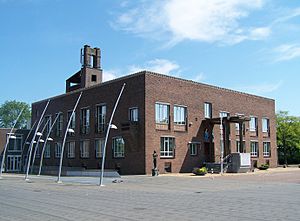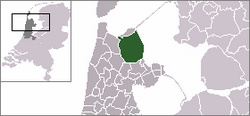Wieringermeer facts for kids
Quick facts for kids
Wieringermeer
|
|||
|---|---|---|---|
|
Former municipality
|
|||

Town hall
|
|||
|
|||
 |
|||
| Country | Netherlands | ||
| Province | North Holland | ||
| Municipality | Hollands Kroon | ||
| Area
(2006)
|
|||
| • Total | 307.76 km2 (118.83 sq mi) | ||
| • Land | 194.82 km2 (75.22 sq mi) | ||
| • Water | 112.94 km2 (43.61 sq mi) | ||
| Population
(1 January 2007)
|
|||
| • Total | 12,676 | ||
| • Density | 65/km2 (170/sq mi) | ||
| Source: CBS, Statline. | |||
| Time zone | UTC+1 (CET) | ||
| • Summer (DST) | UTC+2 (CEST) | ||
| Website | www.wieringermeer.nl | ||
Wieringermeer (Dutch pronunciation: [ˈʋiːrɪŋərˌmeːr]) is a polder and former municipality in the Netherlands, in the province of North Holland. Since 2012 Wieringermeer has been a part of the new municipality of Hollands Kroon.
Population centres
The former municipality of Wieringermeer consisted of the following small towns and villages: Kreileroord, Middenmeer, Slootdorp, Wieringerwerf.
History
Around the year 1000 AD, this area was land. However, several storms after 1100 turned it into a flood plain. Wieringmeer means "Wieringen Lake", the name of an inland lake that filled the area in the early medieval period.
The Wieringmeerpolder is a polder, newly created land, and part of the Zuiderzee Works developed in the 20th century. Originally the polder was planned after the completion of the Afsluitdijk, but a severe lack of agricultural land meant construction was accelerated, starting in 1927. The dikes had to be strong enough to withstand the force of the Zuiderzee, a sea. Draining of the polder was finished on 21 August 1930. After the completion of the Afsluitdijk in 1932, the lake IJsselmeer was formed from the waters.

After desalinization, the new land became usable in 1934. Four villages (Slootdorp (1931), Middenmeer (1933), Wieringerwerf (1936) and Kreileroord (1957)), were developed in the polder.
Since 1 July 1941, the Wieringermeer had been an independent municipality.
On 17 April 1945, during the Second World War, the German occupiers ordered the dike of the Wieringermeer to be blown up: the area was inundated. No one was killed as the polder slowly submerged again (the inhabitants had been warned), but the high water and a subsequent storm destroyed most of the infrastructure built in the previous decade. The floodwater was fresh water, so the land did not have to be desalinated again. Reconstruction followed quickly; by the end of 1945, the polder was declared drained again. Rebuilding of roads and bridges, houses and farms, was greatly facilitated by the experience of building them the first time.
See also
 In Spanish: Wieringermeer para niños
In Spanish: Wieringermeer para niños



